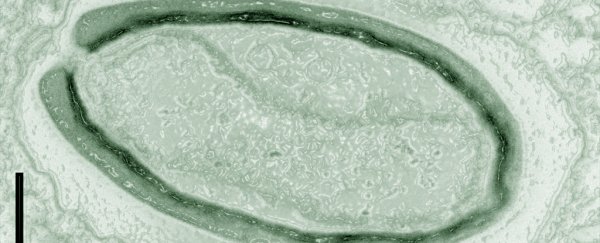They were first discovered on a beach in Santiago, Chile in 2013. And these gargantuan viruses are a far cry from your garden variety, sub-microscopic virus.
Not only are the members of the Pandoravirus family stupidly huge, these microbes also have more genes than any virus has business carrying. Now, the discovery of three new members might finally help us understand why they're so big, and potentially lead us to the origins of all viruses.
A new analysis carried out by French researchers has found that for all the structural and functional similarities between members of Pandoraviridae, the six known examples of these viral heavyweights have surprisingly few genes in common.
Being so big, it's strange to think king-sized viruses like these are so new to science. But their size is precisely why they remained hidden for so long.
The first megavirus family was described in the literature in 2003; it was named Mimiviridae after it was mistaken for a small gram-positive bacterium. Most virus particles are measured on a scale of a handful of nanometres, but not this 'bacteria mimic' – it's hundreds of times bigger, reaching just under a micrometre in size.
In hunting down more examples of Mimivirus in the amoeba cells where they live, researchers stumbled onto a second monster of a similarly impressive size.
Details of two new Pandoravirus species were published in 2013. One was found in sediment on Tunquen Beach in Chile. The other was isolated from amoeba breeding in a pond next to Latrobe University in Australia.
A third was retroactively identified two years later in a case study of amoeba contaminating the contact lens case of a woman diagnosed with keratitis back in 2008.
Most viruses don't tend to need a lot of genes to reproduce - what little they have is used to efficiently hijack the cellular machinery of other organisms. But gigantic viruses make another exception here.
Like Mimivirus, Pandoraviruses have big genomes to match their significant girth. The current record holder is Pandoravirus salinus, at a whopping 2,473 kilobase pairs. So why carry so much when evolution tends to encourage other viruses to travel light?
One clue could be in the nature of these genes. Previous research had shown that just seven percent of them matched genes found in other organisms, indicating they were clearly representing a different evolutionary pathway.
Genes that are unique to any single branch of the tree of life are described as 'orphans'. And it's unusual to see so many orphan genes in one place. This recent discovery of two new Pandoravirus species brings the total to six, and those orphan genes could finally be compared in detail.
The first shock was that they were all unique.
Not only were they orphans in the sense that they didn't match those in any other species, they also were completely unlike the genes in other Pandoraviruses.
But it was the second surprise that gave the researchers a hint as to what was going on. The orphan genes contained signatures of non-coding 'intergenic' regions.
This paints a picture of viruses churning out new, bespoke genes from a noisy mess of non-functional coding, rather than inheriting them from a shared ancestor and then adjusting through mutations.
"If this happens to be true, the long quest for the evolutionary origin of the giant virus genes will end," says senior author Jean-Michel Claverie from the Structural and Genomic Information Laboratory.
This would place these viruses into a rather interesting offshoot of biology, where genes are routinely created from scratch rather than tweaked from a pre-existing library.
Now that we know what to look for, massive viruses are popping up everywhere. Earlier this year, the discovery of two new strains in the Mimiviridae family in Brazil were found to have incredibly complex coding genes.
Their size, complexity, and uniqueness among viruses are providing much needed insight into how this fringe element of biology evolved in the first place.
The debate is far from being settled. But this new find adds an interesting perspective that might suggest the origins of many, if not all viruses lay among the tree of life's deepest roots.
This research was published in Nature Communications.
